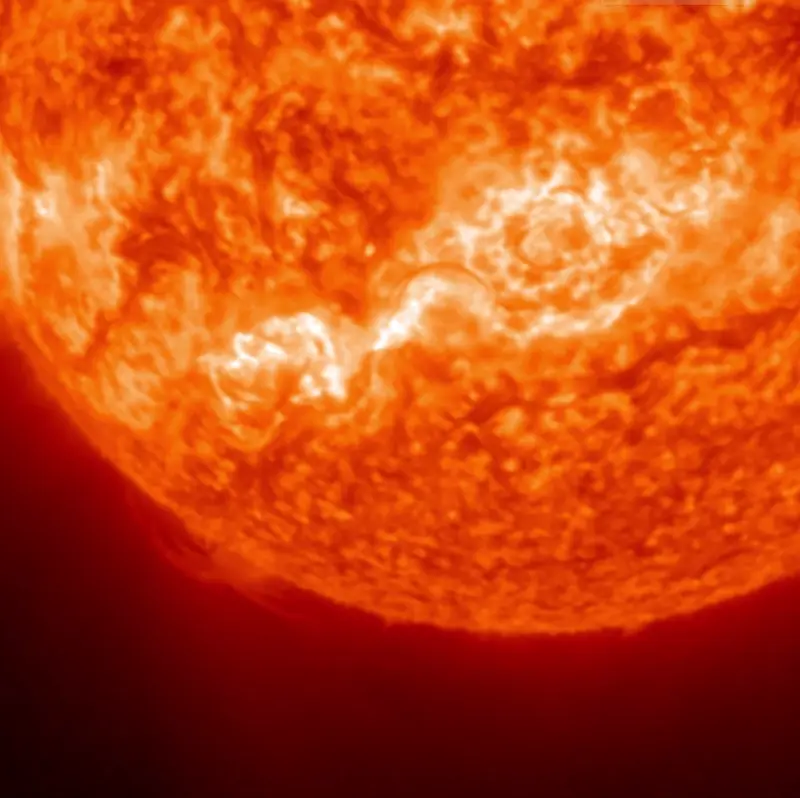
Sun news September 7: Prominence and filament fun
Solar excitement over the past 24 hours focused on filament and prominence activity captured in the 304 angstroms wavelength. The solar limb (edge) was covered with solar prominences, most of which were stable and dancing around. A filament in the southeast erupted in a southward direction around 17:05 UTC. Around 7:30 UTC, we observed loops expanding out from behind the southern solar limb (edge). The very last available SOHO LASCO C2 image shows the beginnings of a coronal mass ejection headed southward. We await more data to learn the details of the event. The flaring activity remains moderate, but just barely, with an isolated small M flare from AR3813. We are very curious about this region or regions on the solar backside. One or more interesting regions could soon rotate into view. Stay tuned!
Last 24 hours: Once again, an isolated M flare during our observation period (11 UTC yesterday to 11 UTC today) kept solar activity at moderate levels. Flaring production reduced from 22 flares to 16 flares, with one M and 15 C flares. The largest flare, an M1.7, blasted out at 7:46 UTC on September 7 from active region AR3813. The flare caused an R1 (minor) radio blackout affecting an area over the Indian Ocean off the west of the Maldives. The lead flare producer of the period was active region AR3806 in the southwest, which produced seven C flares. One of the most active regions during the week, sunspot region AR3807 is now completely out of view in the southwest. Of the seven numbered active regions on the solar disk, there are three sunspot regions with a beta-gamma magnetic configuration: AR3806, AR3811 and AR3813. Active region AR3813 split into two. The western portion kept the number AR3813 while the eastern region is now AR3815. There is a newcomer on the southeast quadrant, AR3816.
Next 24 hours: The chance for C flares is 99%. The chance for M flares is 65%. The chance for X flares is 15%.
Next expected CME: No Earth-directed coronal mass ejections (CMEs) were observed in available coronagraph imagery.
Current geomagnetic activity: Earth’s magnetic field is quiet at the time of this writing (11 UTC on September 7). Quiet conditions are anticipated today, September 8. Unsettled condition are expected to begin on September 8 due to fast solar wind reaching Earth from a coronal hole moving into geoeffective position. This should extend into September 9.
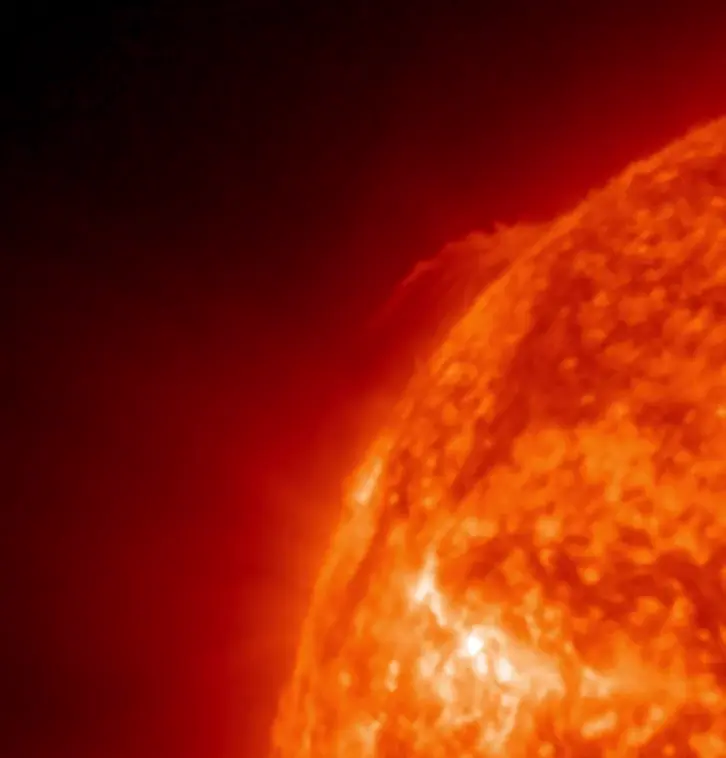
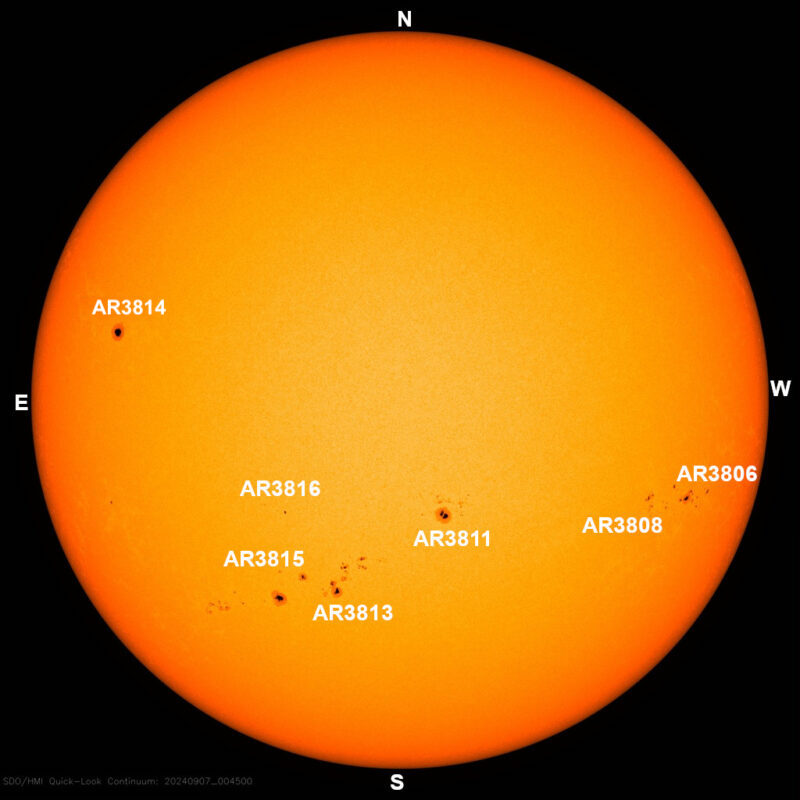
EarthSky’s editor-in-chief Deborah Byrd spoke LIVE with heliophysicist C. Alex Young of Goddard Space Flight Center at 12:15 pm CDT/1:15 pm EDT (17:15 UTC) on Friday, September 6, 2024. Alex is also a co-author of our daily sun update. He told us about this week’s most important sun news: the biggest sunspot number of Solar Cycle 25 so far. Watch the replay.
Sun news September 6: X flare on the sun’s far side
The latest solar excitement has come not from the solar disk facing us, but from the sun’s far side. The SOHO spacecraft’s LASCO C2 and C3 coronagraphs observed a full halo coronal mass ejection (CME), which sometimes means that sunstuff has been blasted straight at Earth … but no eruption was observed on the solar disk. This indicated that the blast actually came from the sun’s rear. And sure enough, the NASA Enlil computer model shows a CME hurled from the far side of the sun. The model estimates that the CME will miss Mercury and will not impact any planet or spacecraft. The STIX instrument onboard Solar Orbiter observed the event, and estimated it to have been caused by a huge X2 flare. So it would have been a big impact if it was heading toward Earth, rather than the opposite direction!
Last 24 hours: Sun activity remains moderate after an isolated M flare. During our observation period (11 UTC yesterday to 11 UTC today), we saw an increase in flare production to the single M flare and 21 C flares. The largest flare was an M1.3 flare produced at 13:25 UTC on September 5 by AR3807. The blast caused an R1 (minor) radio blackout affecting an area over the Atlantic Ocean off the west coast of Africa. The lead flare producer was again AR3807, which blasted 15 flares: the M1.3 and 14 C flares. This departing region also hurled plasma jets into space. There are two active regions on the Earth-facing side of our sun with high-potential beta-gamma-delta magnetic configurations: AR3806 and AR3811. AR3807 and AR3813 have beta-gamma complexities, although it should be noted that AR3807 is too far around the limb (edge) to obtain a reliable magnetic configuration measurement. There are currently six numbered active regions on the solar disk.
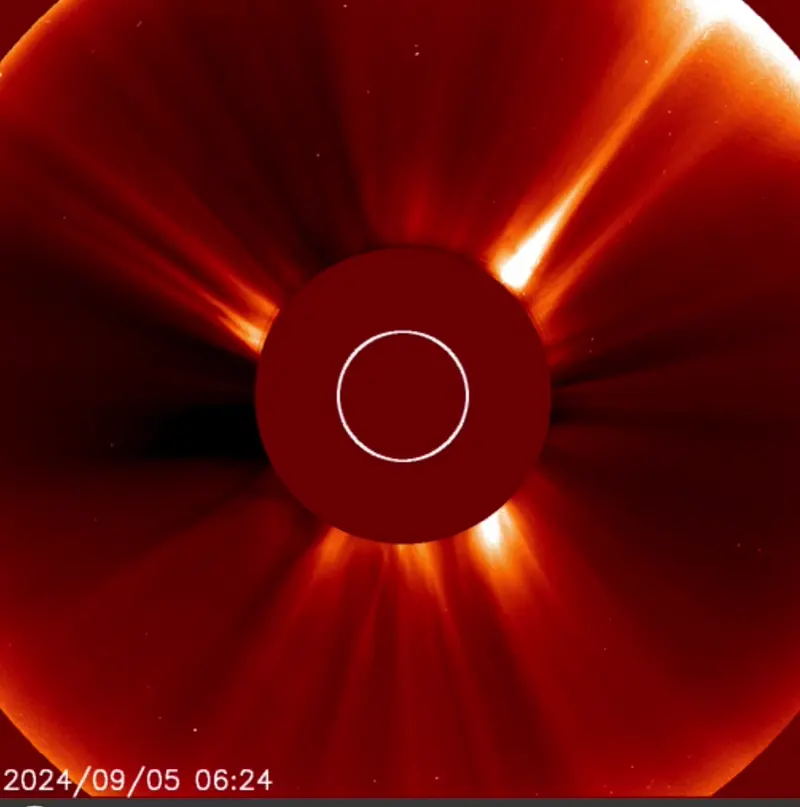
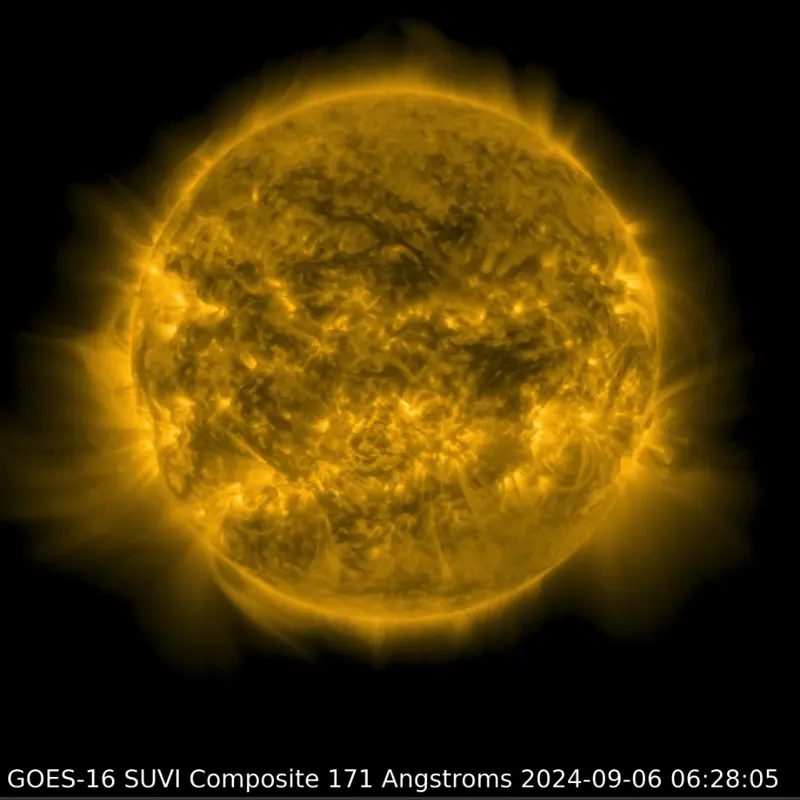
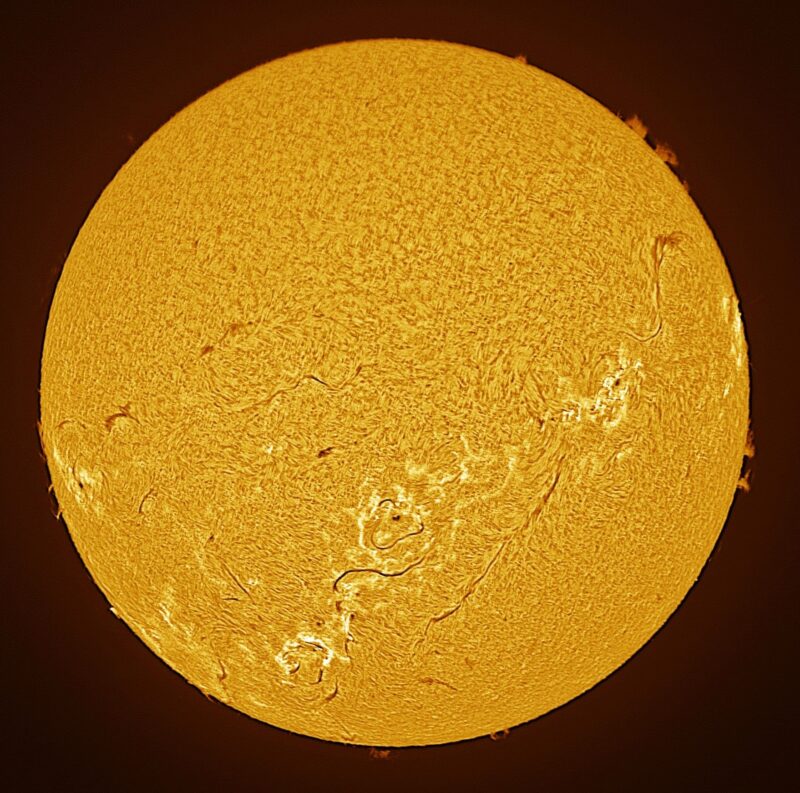
Sun news September 5: Active region goes out with a bang
One of the week’s most active regions has begun to depart over the sun’s southwest limb (edge). It isn’t leaving quietly, though, producing an M2.8 flare on its way out. The largest of 7 M flares produced over the past 24 hours, this blast caused an R1 (minor) radio blackout affecting an area over Somalia. The other blast of excitement came from a filament spewing beautiful jets near AR3811. See the imagery below, along with the cool sight of Earth’s shadow eclipsing the sun from the view of the GOES-R satellite.
Last 24 hours: Seven small M flares have kept solar activity at moderate levels over the past day (11 UTC yesterday to 11 UTC today). The sun produced a total of 20 flares, with 13 C flares adding to the Ms. The largest was an M2.8 at 8:56 UTC on September 5 from AR3807. The event caused an R1 (minor) radio blackout affecting an area over Somalia. The lead flare producer of the period was active region AR3807, which blasted nine flares: three Ms and six Cs. It was closely followed by AR3811, which produced six flares: 2 M and four Cs. The list of M flares is:
• M1.0 at 13:21 UTC on September 4 from AR3813. R1 (minor) radio blackout out over West Africa.
• M1.2 at 20:00 UTC on September 4 from AR3811. R1 (minor) radio blackout out in the middle of the Pacific Ocean southeast of Hawaii.
• M1.0 at 0:20 UTC on September 5 from AR3807. R1 (minor) radio blackout over the Pacific Ocean southwest of Hawaii.
• M1.2 at 3:25 UTC on September 5 from AR3806. R1 (minor) radio blackout over the Philippine Sea off the east coast of the Philippines.
• M1.0 at 3:44 UTC on September 5 from AR3813. R1 (minor) radio blackout over the Philippines.
• M2.8 at 8:56 UTC on September 5 from AR3807. R1 (minor) radio blackout over Somalia. The largest.
• M1.6 at 9:42 UTC on September 5 from AR3807. R1 (minor) radio blackout over Ethiopia.
Sunspot region AR3806 kept its potent beta-gamma-delta magnetic configuration, while AR3807 and AR3813 are showing a beta-gamma complexity. The sun has six numbered active regions on its Earth-facing side. There is a newcomer on the northeast limb (edge), now numbered AR3814. Will this new region match the potential of AR3806 and AR3813 and kick up activity?

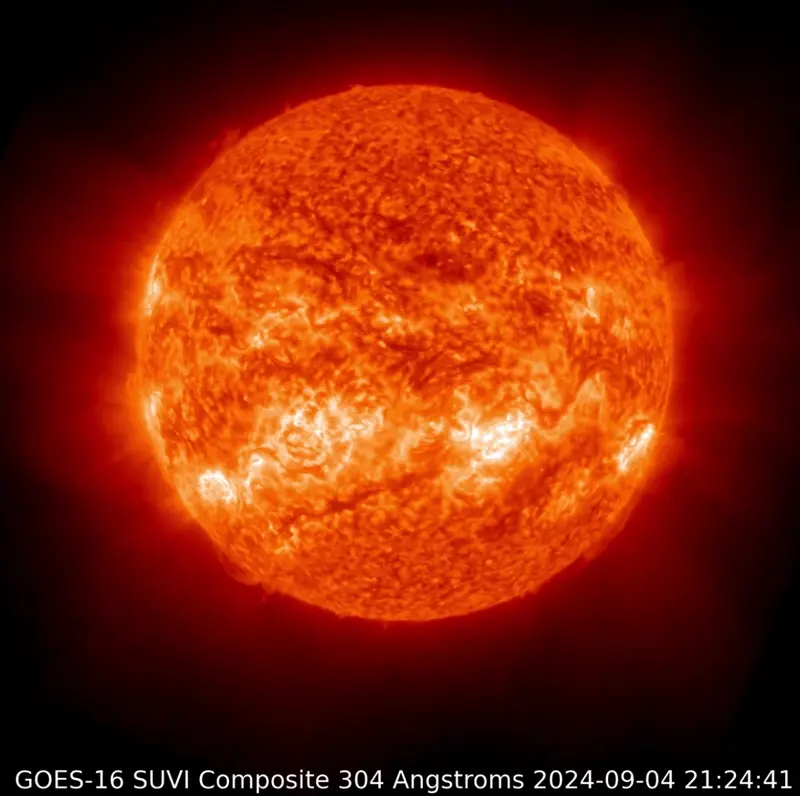

Image via NOAA.
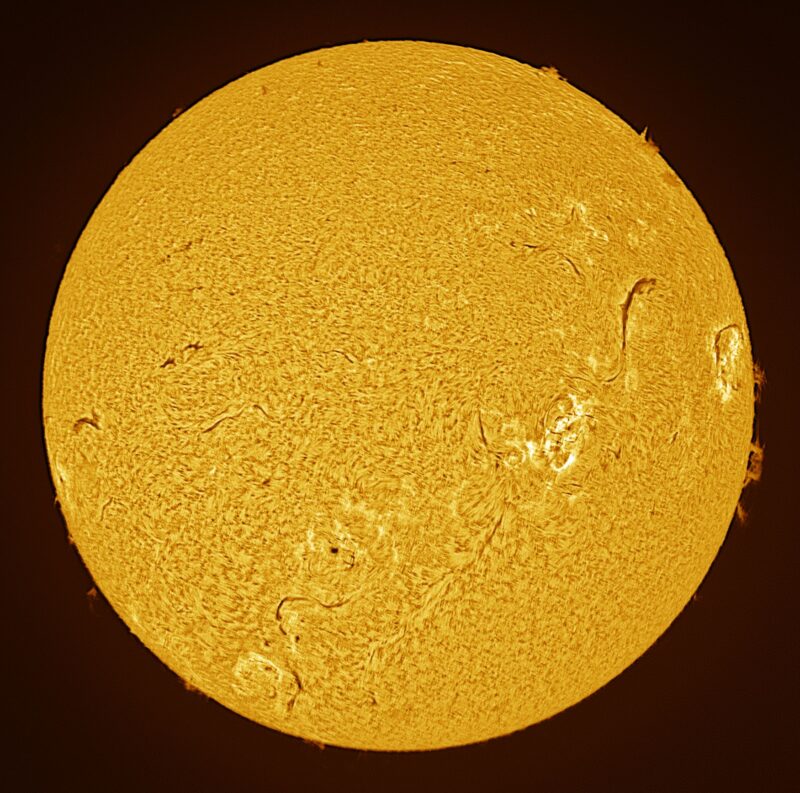
Sun news September 4: Exciting sunspot regions!
Sun activity has been moderate, and was still moderate over the past day. But is higher activity on the horizon? Maybe! Three sunspot regions, AR3806, AR3807, and AR3813, collectively show some exciting potential. These regions – plus a new region on the sun’s northeast limb (edge) – are pushing toward high levels. Over the past day, the three numbered regions produced 20 flares, six M-class, and two approaching M5 (threshold for high activity). The fourth region shows off the sun’s northeastern limb (edge), indicating potential action for that sunspot region once it rotates into view. These regions are magnetically complex, with AR3806 and AR3807 containing delta regions (a sign of the potential for strong M or even X flares). AR3807 is now approaching the sun’s western limb (edge). Soon, the sun’s rotation will carry it out of view. Still, its location on the Earth-facing disk means that – if it produces any solar energetic particles – the chance for them to reach Earth is high, given the location of the sun’s spirally magnetic field with respect to Earth. On the other hand … the sun could surprise us and suddenly quiet down. What will happen? Stay tuned!
Last 24 hours: Sun activity was moderate over the past day (11 UTC yesterday to 11 UTC today), with only M and C flares. During this period, the sun produced six M and 14 C flares. The main flare producer of the past day was AR3806, with 2 M and 6 C flares. AR3813 is in a close second with 4 M and one C flare. AR3807 produced four C flares. AR3806 and AR3807 have beta-gamma-delta magnetic complexity. AR3813 has beta-gamma complexity. All three regions produced flares in the last 24 hours and are worth watching. Yesterday’s far-side eruption produced an increase in solar energetic particles that were measured at Earth, and its effects can be seen as minor snow in SOHO LASCO coronagraph images. The largest flare of the day was an M3.3 at 16:02 UTC on September 3 from AR3813. An R1 (minor) radio blackout affected an area over the Americas.
The list of M flares is:
* M3.3 at 16:02 UTC on September 3 from AR3813. R1 (minor) radio blackout over the Americas. The largest.
* M2.9 at 16:13 UTC on September 3 from AR3813. R1 (minor) radio blackout over the Americas.
* M1.5 at 02:44 UTC on September 4 from AR3813. R1 (minor) radio blackout over Asia.
* M1.3 at 04:56 UTC on September 4 from AR3813. R1 (minor) radio blackout over Asia.
* M1.0 at 06:01 UTC on September 4 from AR3806. R1 (minor) radio blackout over Asia.
* M1.0 at 06:11 UTC on September 4 from AR3806. R1 (minor) radio blackout over Asia.
The sun now has seven numbered active regions on its Earth-facing side.

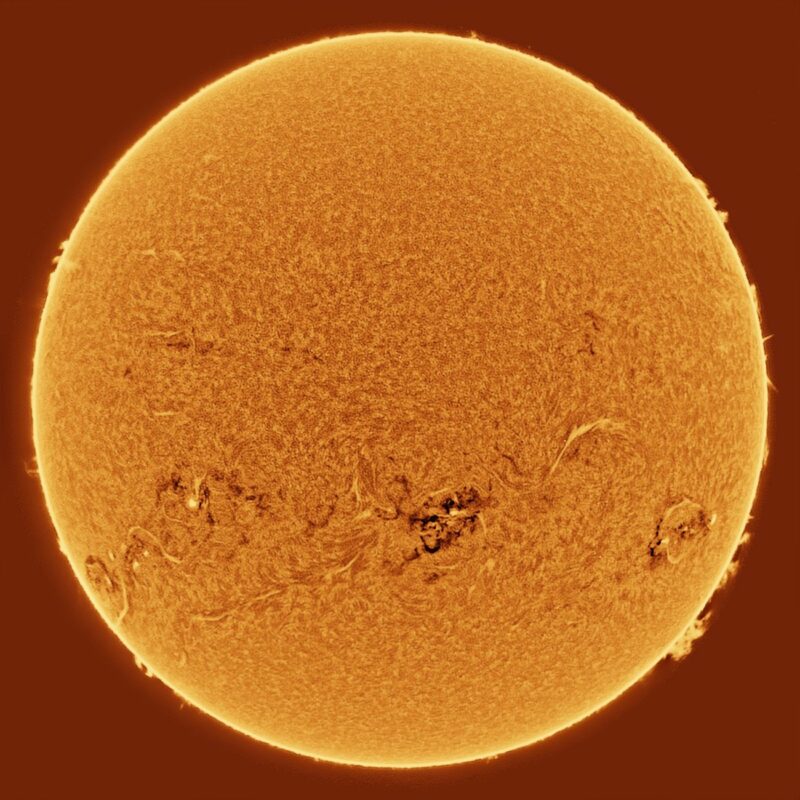
Sun news September 3: August was the peak of Solar Cycle 25, so far
It’s official: the monthly sunspot number for August 2024 is the highest for Solar Cycle 25 so far. The sunspot number for August 2024 reached a 215.5 value. It surpassed the previous peak for this solar cycle, which happened in July 2024, with a value of 196.5. The last time the monthly average was larger than 215.5 was 23 years ago, in September 2001 during Solar Cycle 23 (a value of 238.2). Will Solar Cycle 25 continue this trend? Will September have an even larger monthly sunspot number? Or have we reached Solar Maximum? Time will tell. We’ll be talking more about this on Friday during our all-new and all-cool Sun News of the Week livestream (scheduled for 12:15 p.m. CDT, or 17:15 UTC every Friday).
Last 24 hours: We just passed a period of peak sunspots! But the past week was relatively quiet, and activity has been moderate, with only M and C flares over the past day. The main flare producer of the past day was AR3807. It’s still showing promising potential for even more activity. Another region of interest is AR3813, which produced yesterday’s double M5+ flares with a fast coronal mass ejection (CME) that’s now heading to Venus (see yesterday’s entry). We also saw a large halo CME eruption from the sun’s far side, visible in the SOHO LASCO C2 coronagraph near the end of today’s observation period. From 11 UTC yesterday to 11 UTC today, the sun produced six M and 13 C flares. AR3807 had 13 flares, three Ms, and 10 Cs. The largest flare of the day was an M2.9 at 14:42 UTC on September 2 from AR3807. An R1 (minor) radio blackout affected an area over the Atlantic Ocean. The list of M flares is:
* M1.8 at 13:27 UTC on September 2 from southeast. R1 (minor) radio blackout over the Atlantic Ocean off the west coast of Africa.
* M2.9 at 14:42 UTC on September 2 from AR3807. R1 (minor) radio blackout over the Atlantic Ocean. The largest.
* M1.4 at 20:11 UTC on September 2 from AR3807. R1 (minor) radio blackout over the Pacific Ocean.
* M1.8 at 21:02 UTC on September 2 from southeast. R1 (minor) radio blackout over the Pacific Ocean.
* M1.6 at 23:01 UTC on September 2 from AR3807. R1 (minor) radio blackout over the Pacific Ocean in the middle of nowhere south of Hawaii.
* M1.5 at 7:22 UTC on September 3 from AR3813. R1 (minor) radio blackout over the Indian Ocean off southeast India.
The sun now has nine numbered active regions.

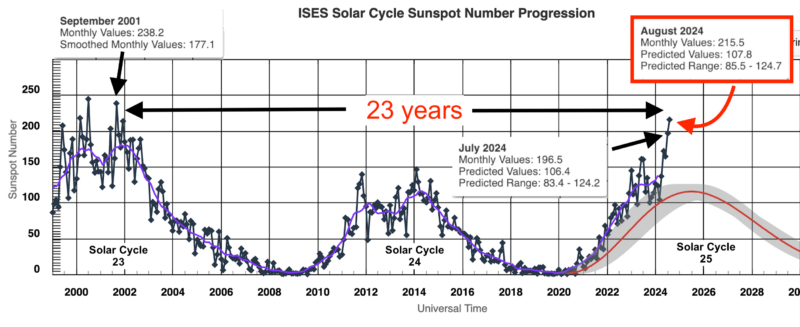
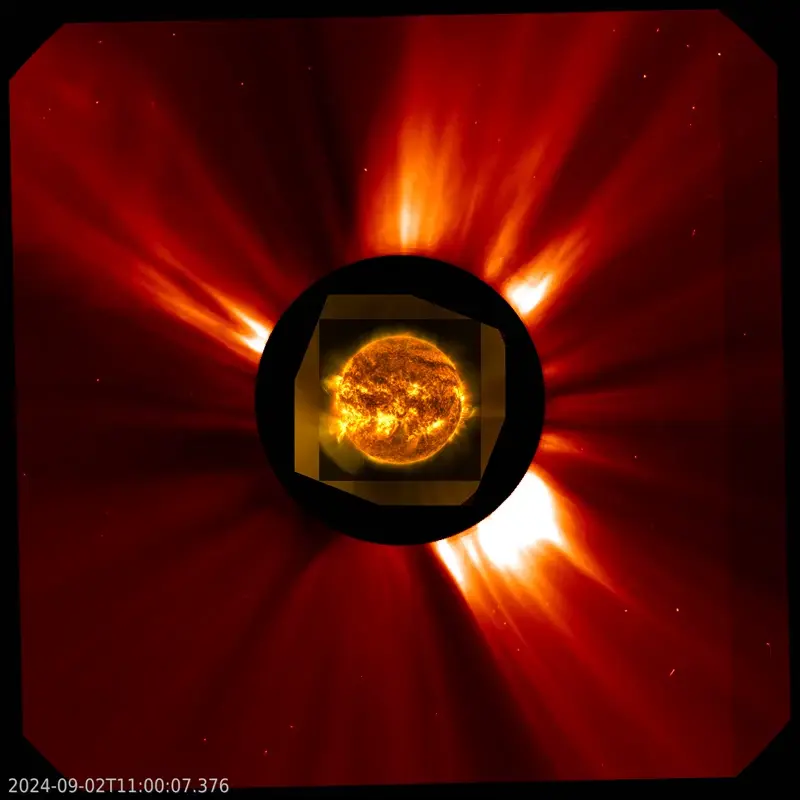
Sun news September 2: Large eruption headed to Venus
Shortly after yesterday’s sun news report, an at-the-time unnumbered region just over the sun’s southeast limb (edge) went BOOM! An eruption released a large flare made of two M5+ flares, along with a massive blob of sun stuff. Initial computer models from NOAA and NASA indicate that this eruption – called a coronal mass ejection (CME) – will not strike Earth. But look out, Venus, because it’s coming your way! Unlike our planet, Venus doesn’t have a magnetic field, the invisible force field that helps to protect our atmosphere from the ravages of the sun. We may never know for certain what impact this CME will have on the atmosphere of Venus, since there’s no orbiting spacecraft at Venus now. But this CME impact could strip some of the atmosphere away from Venus. By the way, this September 1-2 flare event might have been larger than could be measured from Earth. The flares took place just out of our view, and the sun blocked or occulted part of them. Now we wait to see if this new region will bring more action on the Earth-facing side of our star, as it rotates more fully into view. Stay tuned.
Last 24 hours: Sun activity is high, thanks to two M5+ flares. During our observation period (11 UTC yesterday to 11 UTC today), the sun produced five M and four C flares. This M activity came from a new region on or behind the southeast limb (edge) that we believe is the now-numbered region, AR3813. Active region AR3813 released the largest flare of the day, an M5.6, at 13:31 UTC on September 1. It caused an R2 (moderate) radio blackout over the Atlantic west of Africa. The lead flare producer of the period was active region AR3813, which produced five M flares. The list of M flares during the period:
• M5.5 at 13:22 UTC on September 1 from AR3813. R2 (moderate) radio blackout over the Atlantic Ocean west of Africa.
• M5.6 at 13:31 UTC on September 1 from AR3813. R2 (moderate) radio blackout over the Atlantic Ocean west of Africa.
• M1.1 at 20:00 UTC on September 1 from AR3813. R1 (minor) radio blackout over the Pacific Ocean west of the Americas.
• M1.5 at 22:48 UTC on September 1 from AR3813. R1 (minor) radio blackout over the Pacific Ocean west of the Americas.
• M2.0 at 05:29 UTC on September 2 from AR3813. R1 (minor) radio blackout over Asia.
Today, the sun has 11 numbered active regions, including two new numbered active regions, AR3812 and AR3813. AR3807 continued its growth while the remaining regions were stable or in decay.

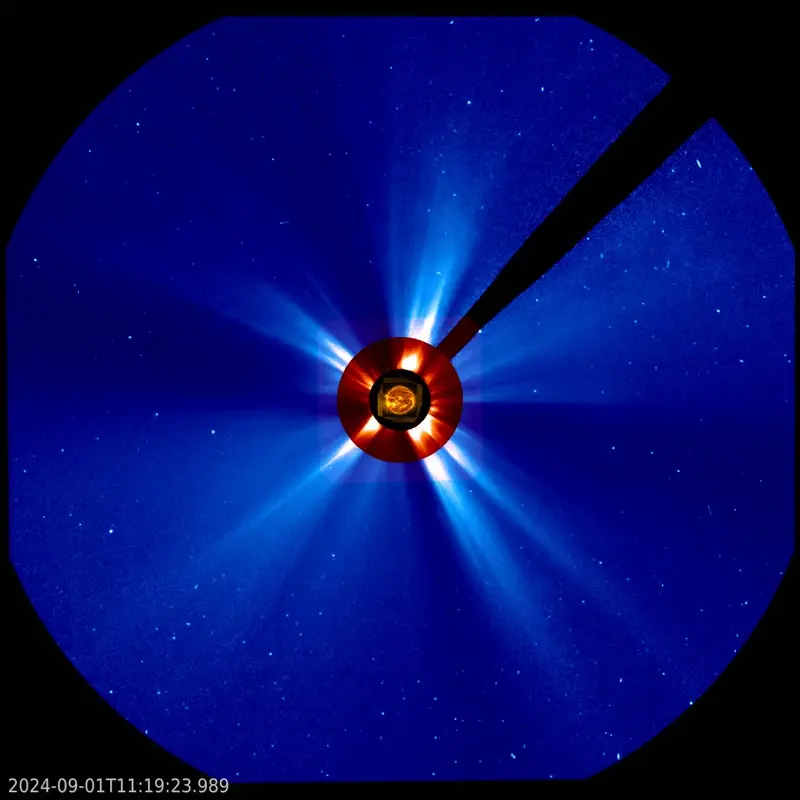
Sun news September 1: Activity coming over east limb
Activity has calmed slightly, but remained at moderate levels over the past day. Most of the approaching activity is rotating into view over the sun’s eastern limb. Region AR3806 looked promising, but has lost some of its flare-producing potential. During the last 24 hours, Earth’s magnetic field experienced a brief period of a G1 (minor) geomagnetic storming, thanks to high-speed solar wind from a coronal hole. After the geomagnetic storm, the geomagnetic field cooled to active, then quiet levels, and remains there at the time of this writing (11 UTC on September 1). The most active regions on the sun in the past day were AR3806 and the as-yet-unnumbered region on the southeast limb (edge).
Last 24 hours: Sun activity is moderate , thanks to two M flares. During our observation period (11 UTC yesterday to 11 UTC today), the sun produced 14 flares, two M and 12 C flares. Active region AR3806 released the largest flare of the day, an M1.8 at 13:02 UTC on August 31. It caused an R1 (minor) radio blackout over the Atlantic east of Africa. AR3806 lost its beta-gamma-delta magnetic configuration. The lead flare producer of the period was active region AR3806, which produced five flares. The list of M flares during the period:
• M1.8 at 13:02 UTC on August 31 from AR3806. R1 (minor) radio blackout over the Atlantic east of Africa.
• M1.4 at 07:57 UTC on September 1 from incoming unnumbered active region. R1 (minor) radio blackout over the Indian Ocean.
Today the sun shows ten numbered active regions. There are three new active regions, AR3809, AR3810, and AR3811. Regions AR3806 and AR3807 have beta-gamma magnetic complexity and the remaining regions are either alpha or beta. By the way, there was some breaking news late last week on the mechanism that causes it. EarthSky’s Deborah Byrd spoke LIVE with one of the study’s authors; replay in the video below:

The sun in recent days
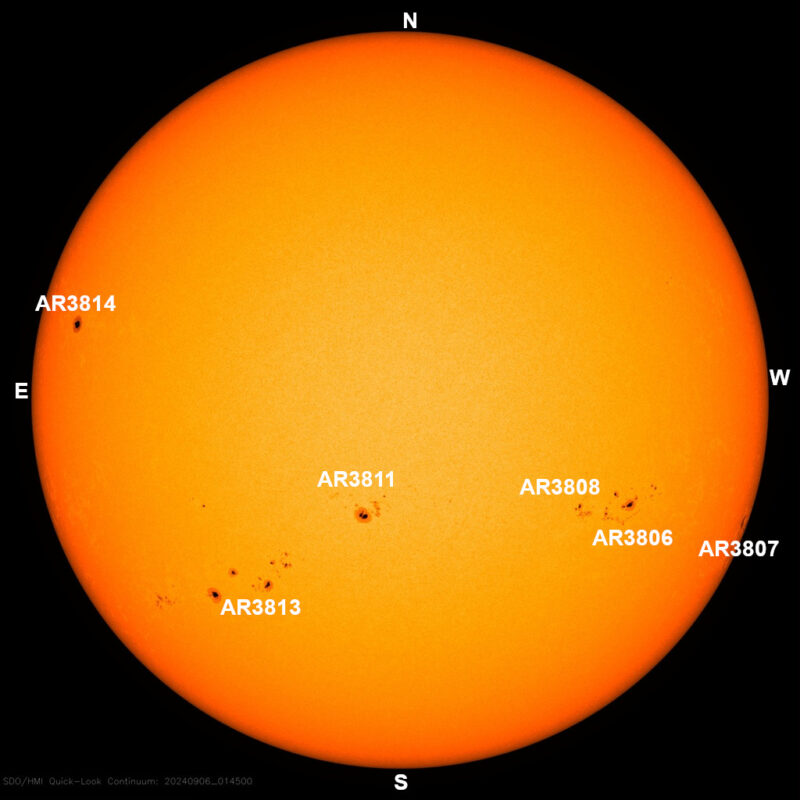
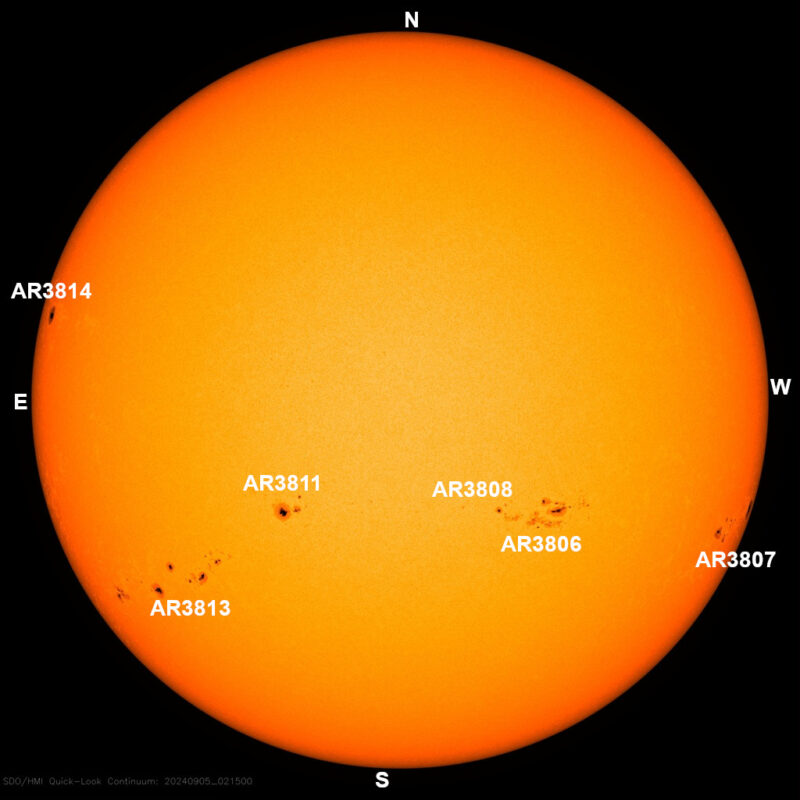
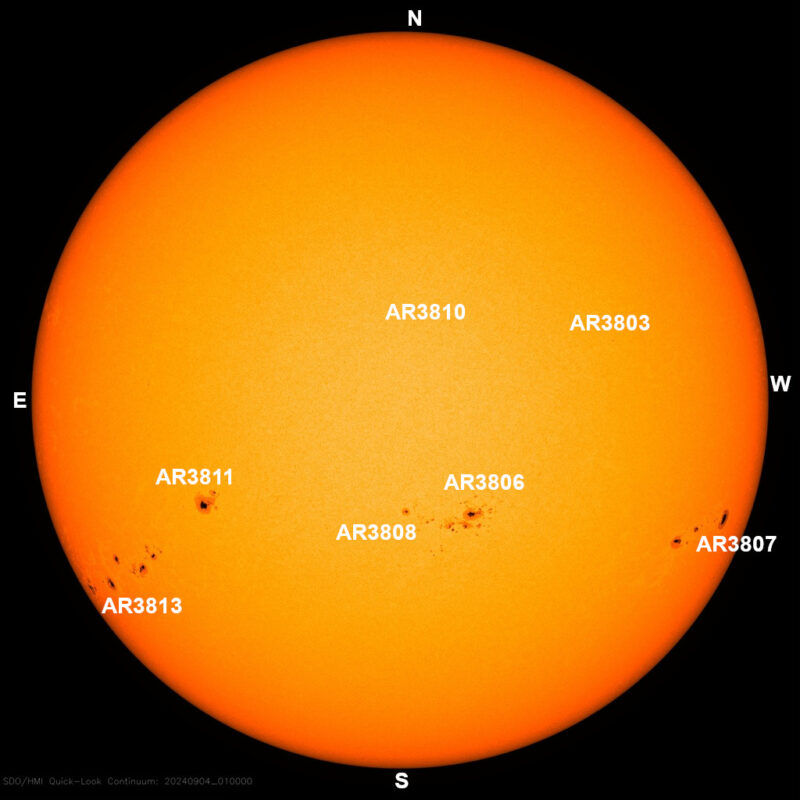
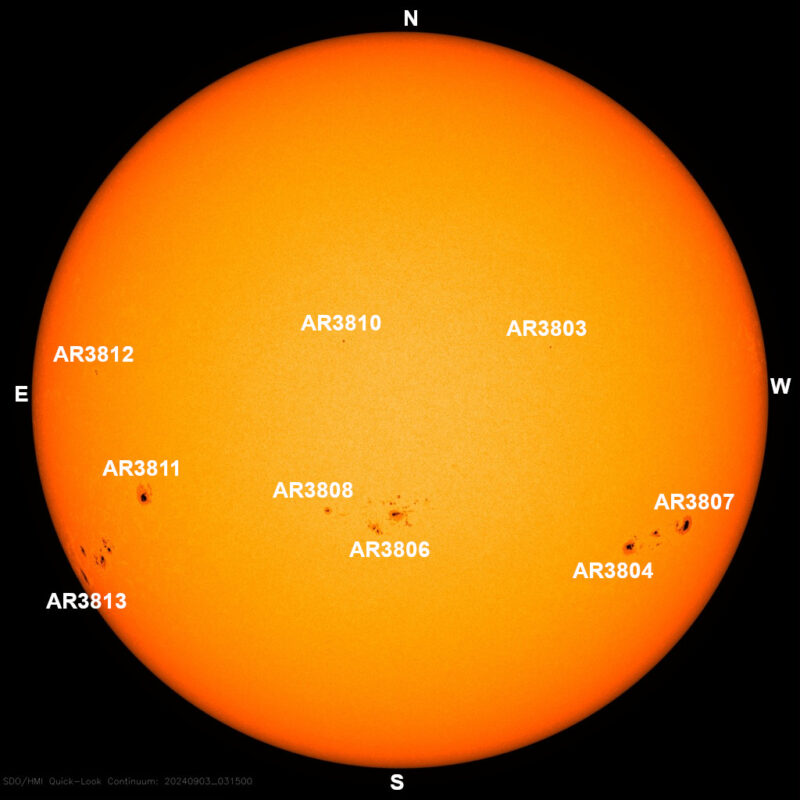


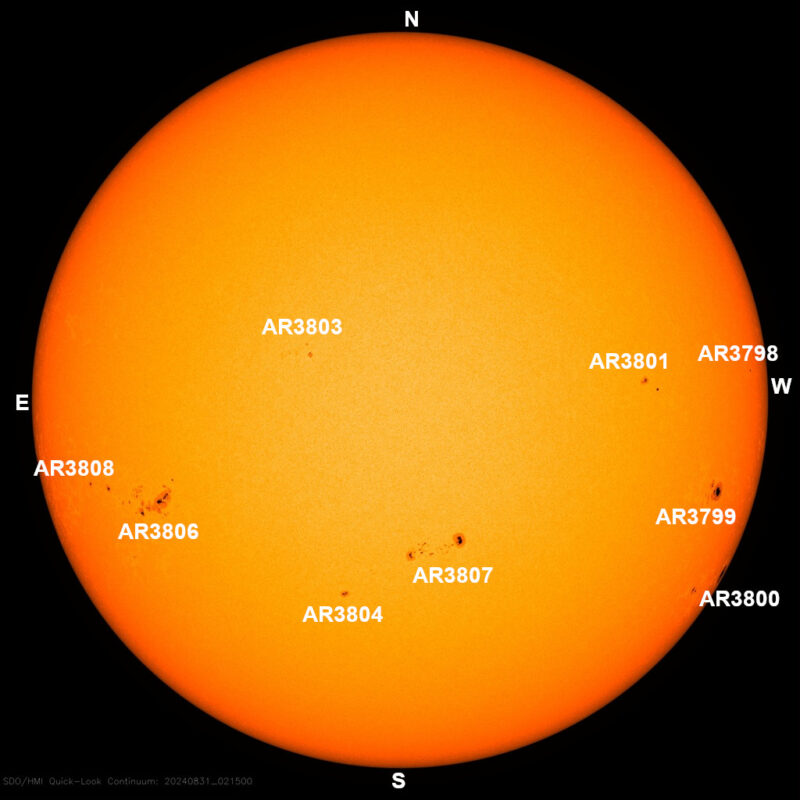
Sun images from our community


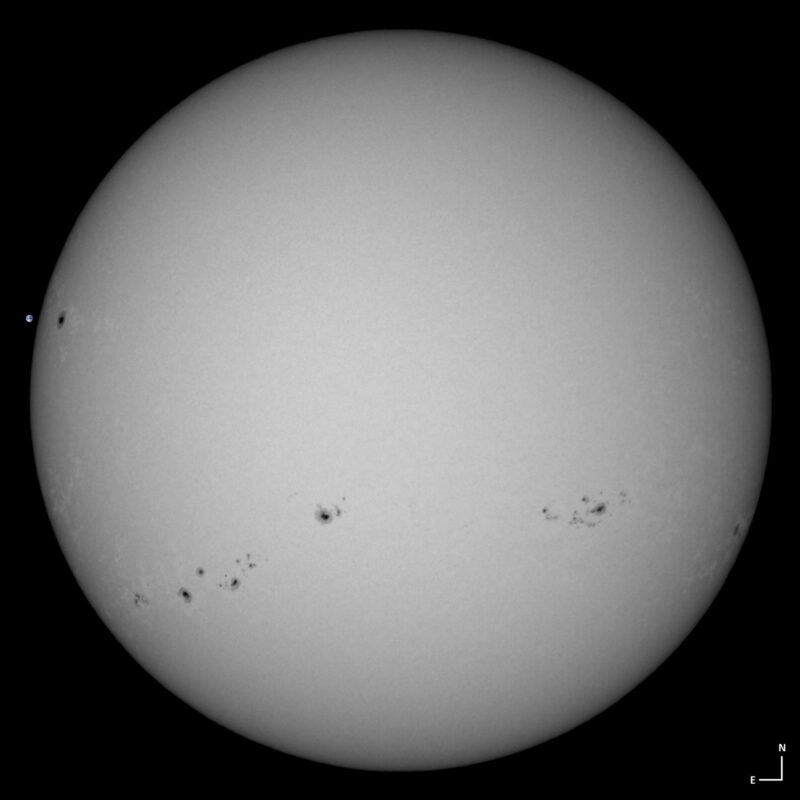
Are you a fan of sun images? We invite you all to send us your beautiful recent photos of sunspots and auroras. We love receiving them and sharing them! And to those of you who’ve already posted a photo to our community page, thank you.
Bottom line: Sun news for September 7: Sun fun focused on prominences and filaments across our star and along the limb. Flare activity just barely retained moderate levels.











